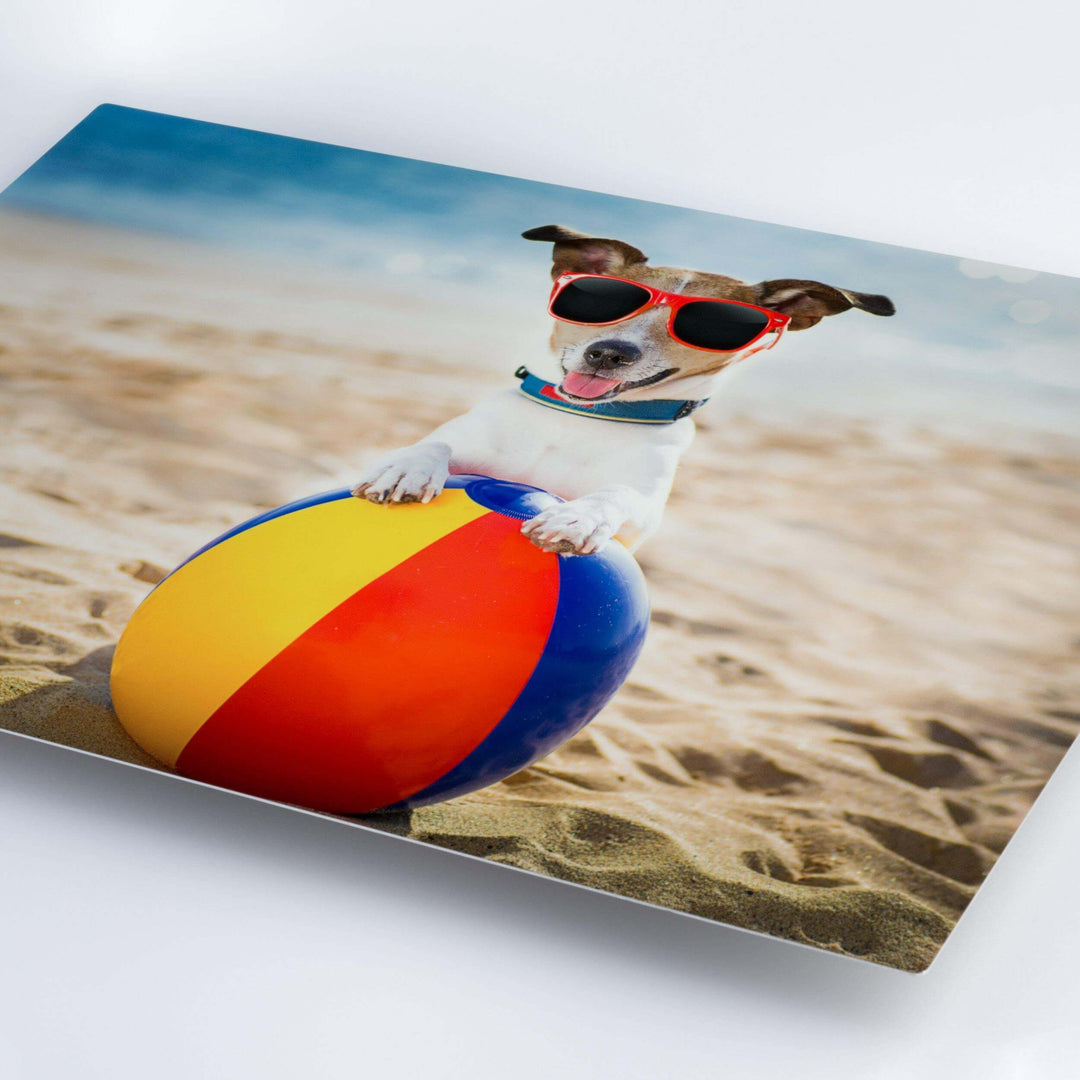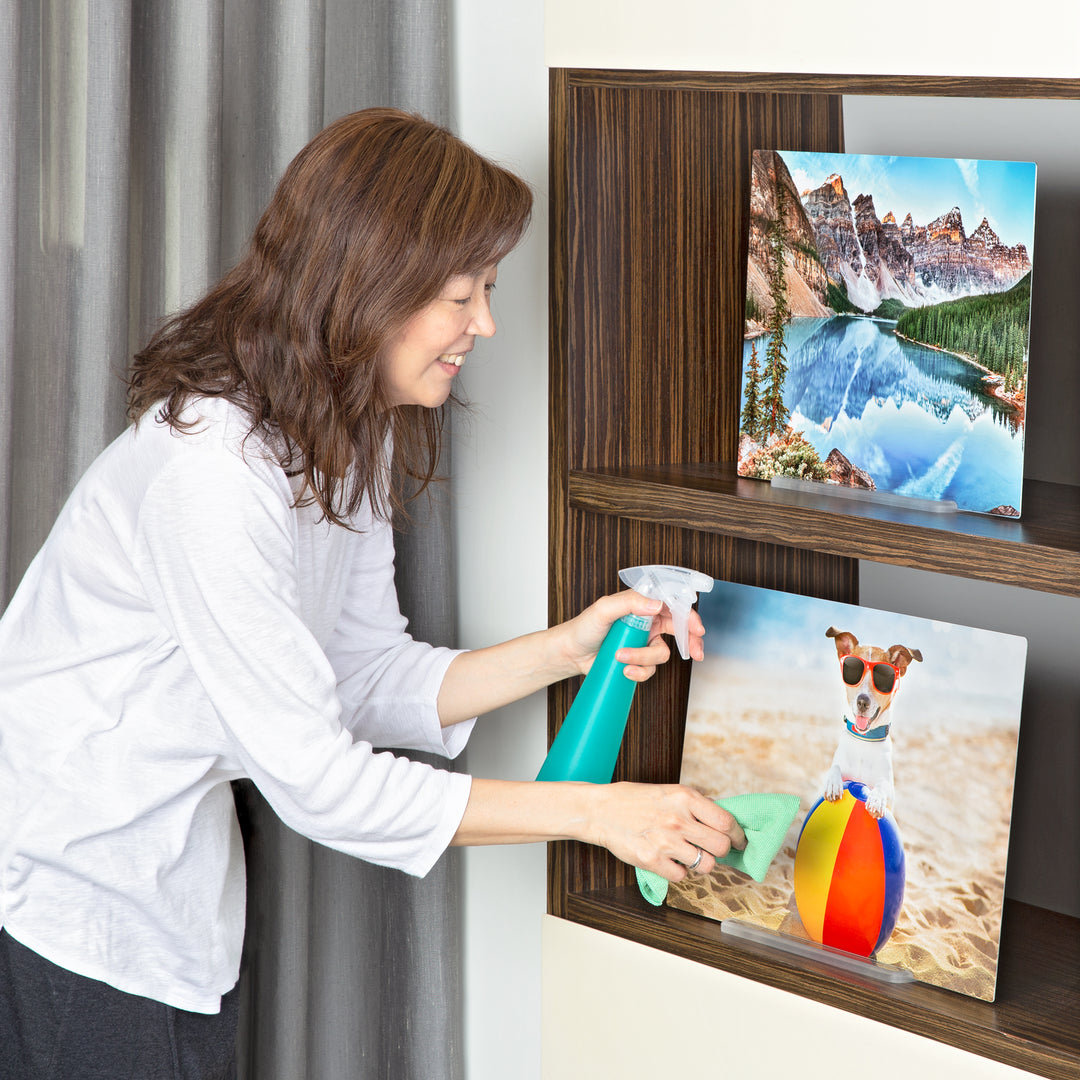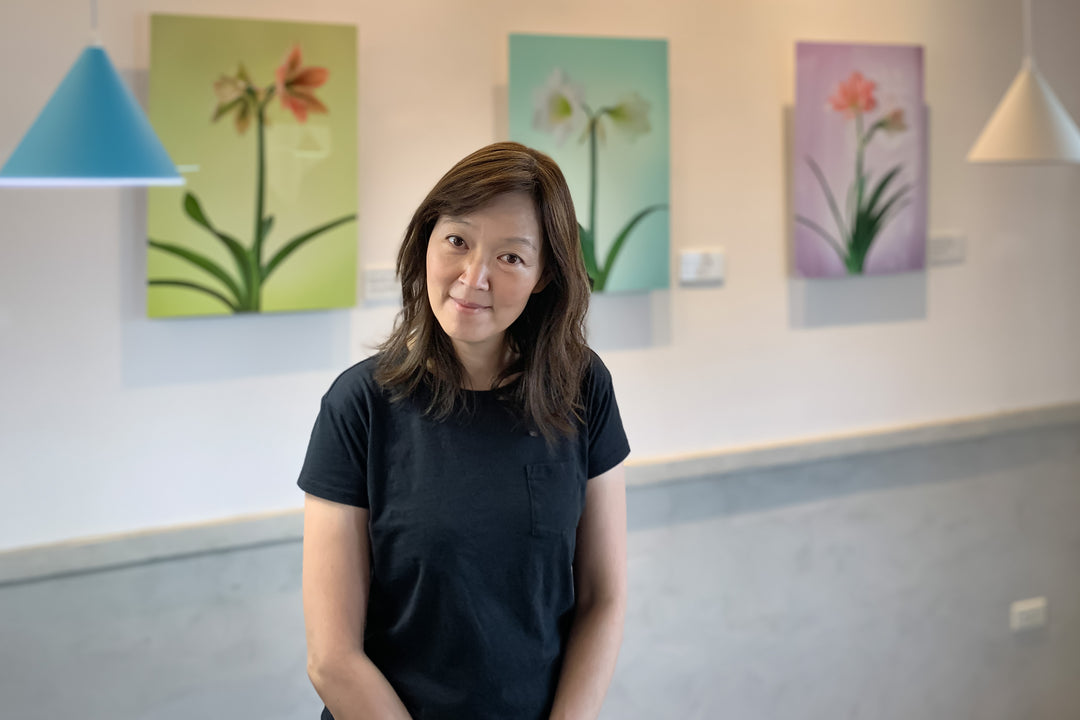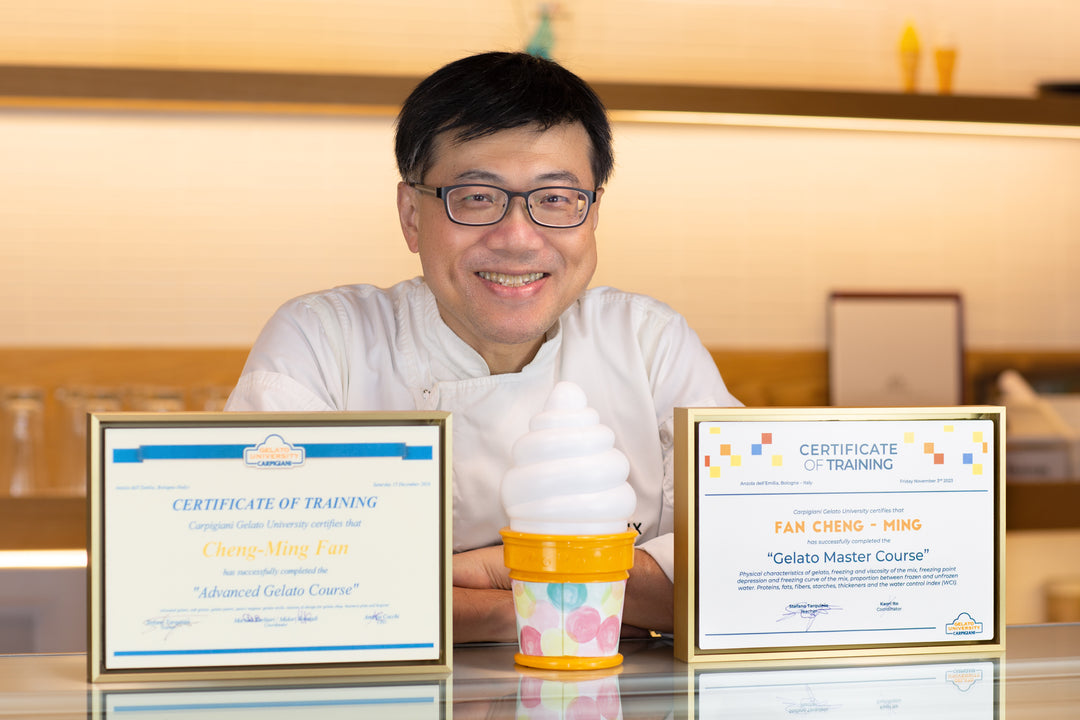Due to its excellent color rendering and extremely high resolution, art giclée is one of the most widely respected output methods in contemporary digital image display.
However, in terms of preservation, although it is often said that "it can be preserved for 60 years without fading", we often hear photographers or collectors complain that their works become moldy, yellowed or deteriorate within a few years.
These experiences prompted us to further explore: What is the basis for evaluating the durability of art giclee printing? Do its testing conditions reflect our actual daily use environment?
This article will be divided into two parts:
- In the first half, we will introduce the testing methods and evaluation results of William Imaging Research (WIR), an international professional research organization, to help you understand the basis and limitations behind official durability data.
- In the second half, we compiled Taiwan’s historical climate data (temperature and humidity changes) and compared it with the WIR test conditions to explore whether the results can be reasonably applied to Taiwan’s living environment.
Finally, we also propose a display solution that is more suitable for hot and humid climates: "ChromaLuxe Metallic Photos" for reference by image creators who require durability.
If you want to understand giclee print from a broader perspective, including its applications, paper selection, and price analysis, please refer to the extended reading: What is giclee print? Details you must know when choosing giclee print .
Why talk about durability?
1. Summary of durability analysis
Whenever giclee paper or printer/printer manufacturers claim that their giclee prints can last "over 60 years without fading," "70 years without fading," or "100 years without fading," we must understand that what these giclee print manufacturers are actually referring to is the achievable preservation period achieved by maintaining a strictly controlled low temperature (24°C) and low humidity (50% relative humidity) environment in professional institutions such as art museums .
If our real-life environment lacks these temperature and humidity conditions—that is, if the typical indoor environment in Taiwan cannot consistently maintain a temperature of 24°C and a relative humidity of 50% —then giclee prints will not be able to "be preserved for over 60 years," "be preserved for 70 years," or even "be preserved for a century" without deteriorating.
2. Get to know William Imaging Research, a specialized research organization
Why should you know William Image Research? Because they're a leading authority on research and testing the durability of giclee prints. All claims about the durability of giclee prints are based on their research, so we're taking a moment to briefly introduce them.
Wilhelm Imaging Research, Inc. (WIR), co-founded by Henry Wilhelm (hereafter referred to as "Henry Wilhelm"), is an independent research organization specializing in the stability and preservation of traditional color photographs, digital color photographs, and film. WIR publishes durability data for various brands of desktop and large-format inkjet printers and other digital output devices. WIR also provides consulting services to facilitate the long-term preservation of photographs and film at sub-zero temperatures for museums, archives, and commercial collections.
William received a one-year Guggenheim Fellowship in 1981, which turned into a ten-year study of color print fading and staining under low-level tungsten lighting, simulating museum exhibition conditions. Meanwhile, in the early 1980s, while serving as technical advisor to film director Martin Scorsese, William successfully persuaded Eastman Kodak and Fuji Photo Film Co. Ltd. to improve the stability of their color negative and color films.
Co-founder Henry William, who is also the organization's president and research director, remains very active at industry conferences, trade shows, and museum preservation meetings, speaking on topics such as giclee printing technology and the durability of works.
In summary, WIR has been a vital research institution in the imaging industry since the early 1980s. They continuously conduct and publish research, providing insights into the shelf life of various giclée papers and inks offered by various manufacturers under various testing conditions.

How to assess durability? —WIR report interpretation
1. Understand how to interpret the "Giclee Display Durability Rating" report
Each WIR research report tests and studies a specific brand/model of printer (e.g., Epson SureColor P20570, Epson SureColor P5370), different ink types, and different photo paper brands and types, and publishes the results in a uniform report format.
Therefore, each WIR test report on the durability of giclee prints includes the following parameters:
- Brand of printer or output machine
- Printer and output device models
- Type of ink used by the output machine
- Types of Paper for Giclee Printing
- Designated test environment
That is to say, when different brands and models of art giclee printers use different inks, and the display and preservation environment (temperature, humidity) changes, even if the output is printed on the same art giclee paper, different results will be produced.
Each test in these professional studies is conducted under controlled conditions, so all reports include detailed notes detailing the testing environment and conditions. We can conclude that even if the same printer model and ink are used, if the storage environment differs from the WIR test, the durability demonstrated here cannot be compared to the WIR test results.
Therefore, only when all parameters are exactly the same can we claim that XX art micro-spray has such and such display and preservation durability.
2. Carefully review the report on the durability of giclee prints.
We'll use a WIR research report as an example to analyze its findings. This report, published on April 29, 2024, tested the Epson SureColor P20570 large-format printer, using Epson UltraChrome Pro12 pigment inks and printing on seven types of Epson photographic art paper.
Because the organization WIR does not have open authorization, we cannot reprint their research data in this article. Therefore, we have attached the original link here. Please click on the link to view the original text!
Original link: "Epson SureColor P20570– WIR Print Permanence Ratings"
2-1 Environment and conditions used in WIR durability testing
Since the industry does not have a standard for indoor display and storage conditions (such as lighting brightness, ambient temperature, humidity and indoor ozone concentration), as well as a standard for judging fading and color imbalance, WIR uses its own standards.
All WIR-related tests are conducted under the following unified conditions:
- 24°C constant temperature
- 50% relative humidity
- The work is in an environment under a glass frame
- Taking the lighting conditions of 25,000 lux (25 klux) and cool white fluorescent lamps, extrapolated to 450 lux conditions for 12 hours a day,
- The judgment criteria are based on WIR's custom-defined "Visual Weighted Endpoint Criteria v3.0"
2-2 WIR durability test, what items are tested?
WIR measured the durability of artwork printed on various Epson giclee art papers using Epson UltraChrome Pro12 pigment inks, using the aforementioned testing environment. The results were published on Epson's SureColor P20570 large-format printer.
"Shelf life" refers to the number of years after which the naked eye may notice slight fading or changes in color balance when compared to a newly output image.
(Note 2 to Years Before Noticeable Fading and/or Changes in Color Balance Occur)

2-3 Detailed description of WIR test results
Taking "Epson Exhibition Fibre Art Paper" as an example, the WIR display durability test results are as follows:
- The giclee prints are displayed in glass frames and have a 122-year shelf life.
- Giclee works are displayed in UV-protected glass or acrylic frames and have a 184-year shelf life.
- If the giclee print is not framed in a glass or acrylic frame, it has a shelf life of 77 years .
- Giclee works have a shelf life of over 300 years in a dark environment at 22.7°C and 50% relative humidity.
At first glance, the results are very attractive, but don't forget that the prerequisite for obtaining these test results is to have such a saving environment:
WIR test environment: 24°C temperature and 50% relative humidity
This alone makes the research results difficult to apply to the general environment in Taiwan...
Of course, if the display and preservation space can have 24-hour temperature and control devices like large professional institutions such as art galleries and museums, then the results of this research report will still be of reference value.
If you are interested in learning more about the detailed notes of the WIR report, we have listed the notes of the report here (with a brief Chinese translation). Please feel free to refer to it.
2-4 Notes in the WIR report (brief Chinese translation)
What is the durability of works displayed under glass frames?
What is the durability of works displayed in UV-protected glass or acrylic frames?
Does the work without glass or acrylic frames show "durability"?
- "Gas fading" is another potential problem, especially when displayed on magnetic kitchen refrigerator doors, office walls, or in daylight glass display cabinets. Dye inks are printed on microporous, quick-drying photo paper, which is least resistant to exposure to ozone in the air.
- Dirty outdoor air is the source of most ozone in homes, offices, restaurants, and public buildings. Ozone can also be produced by electrical equipment, such as electrostatic air filters, electrostatic dust removal systems, and even desktop electrostatic air filters. Other airborne pollutants include kitchen fumes.
- If the same report shows a lower "durability period" for ozone resistance, the lower data should be used as the primary indicator. Finally, regardless of the ink used or the material used, all artwork should be protected with glass or acrylic frames.
(Note 5 to Displayed Prints Not Framed (Bare-Bulb))
Analysis of moisture resistance and water resistance of exhibited works
Place the work under high humidity and high temperature conditions and observe the image color, color concentration, and the degree of ink bleeding.
- Conduct moisture resistance test on the work in an environment of 30°C and 80% relative humidity
- Depending on the ink/paper material combination, image color, density, and ink can be affected by humidity even at much lower humidity levels, such as 50–60% relative humidity.
- The water resistance of the works was tested by "dripping water" and "gently wiping" the works. Based on the test data, the results were displayed in three subjective categories: "high", "moderate", and "poor".
- When testing the water resistance of the artwork, although the artwork itself is highly water-resistant, the absorbent paper substrate itself may warp, curl, and physically deform after contact with water. Therefore, the water resistance of the paper and ink combination is classified as "moderate".
- Since 1996, Mark McCormick-Goodhart and Henry William of WIR have been developing test methods for the moisture resistance of artworks, as well as related test methods for evaluating the "short-term color shift" of inkjet artworks. The notes to the test report also list several research reports between 2000 and 2005 as references.
(Note 8 of Resistance to High Humidity and Notes 9 and 11 of Resistance to Water)

Taiwan's climate and suitability analysis
1. Data collection: Taiwan’s historical climate data
After understanding the testing environment used by the research organization WIR in its studies, we intuitively felt that these data could not be applied to the Taiwanese environment. However, such a conclusion would be too hasty and unscientific. Therefore, we must first obtain relevant data from Taiwan's real environment and organize it into the information we need before we can determine whether this WIR-type report is applicable to Taiwan.
From the WIR research report above, we can see that the report is very detailed. For example, indoor lighting brightness, ozone concentration, and kitchen fumes, although they are variables in a micro space, their views are listed in the report for us to understand.
It's worth noting that WIR clearly lists the ambient temperature and humidity used during testing. These are also the general climate conditions for which we can obtain official data for comparison and analysis. Therefore, we decided to start with these two criteria to see if WIR's research report is applicable to Taiwan's environment.
The following is the official data we obtained over the past 30 years after our investigation.
| 1991 - 2020 | Average temperature |
Number of days per year with temperature ≥ 25℃
|
Number of days with maximum temperature ≥ 30℃ per year | relative humidity |
| Taipei | 23.5°C | 151.1 days | 135.7 days | 74.8% |
| Hualien | 23.7°C | 160.0 days | 123.5 days | 77.3% |
| Yilan | 22.8°C | 145.3 days | 122.4 days | 80.7% |
| Kaohsiung | 25.4°C | 223.8 days | 173.7 days | 75.0% |
| Taichung | 23.7°C | 179.6 days | 170.9 days | 74.5% |
From Table 1 above, we can summarize Taiwan’s climate over the past 30 years (1991 to 2020):
2. Data Collection: Taiwan's Climate
Temperature in Taiwan
From 1991 to 2020, the number of days with temperatures exceeding 25°C varied slightly across Taiwan's five cities: East, South, West, North, and Central, but accounted for at least one-third of the year, ranging from 145 to 223 days, with at least 122 of those days.
Humidity in Taiwan
During the period 1991-2020, the average relative humidity in the five cities of Taitung, South, West, North and Central was above 74%, with Yilan reaching a maximum of over 80%.

3. Climate Inference: Can the WIR test results be applied to Taiwan?
WIR testing is conducted at a constant temperature of 24°C and a relative humidity of 50%, which is not suitable for Taiwan's climate. We can further speculate that if the output material can demonstrate heat resistance (for example, flame resistance) and water resistance (for example, the material can be sprayed with water and easily wiped dry), proving that the material is heat-resistant and water-resistant, then the WIR test results will be applicable to Taiwan's relatively hot and humid environment.
Note 11 also mentions the paper base of a giclee print as a factor in consideration and judgment. This makes sense: the ink adheres to the coating, which in turn adheres to the paper base (or material). If the paper is negatively affected by heat and humidity, the giclee print will also be affected. This resonates with common sense: how can paper remain intact after being exposed to moisture or water? Therefore, if the paper is subject to deformation, the ink and image on it will inevitably be affected.
In summary, the WIR test results are suitable for reference by professional institutions such as art galleries and museums, as these institutions are capable of maintaining a constant temperature of 24°C and a relative humidity of 50%. However, for those of us living in homes, offices, and open public spaces, if the display conditions cannot be maintained below Taiwan's 24°C and 50% relative humidity, the WIR test results are not suitable for the display lifespan of the work. This conclusion should be understandable.
In other words, whenever photo paper and ink manufacturers cite WIR research data, claiming their paper or ink can last "over 60 years without fading," "70 years without fading," or "100 years without fading," we should understand that they are actually referring to the lifespan achievable in a strictly temperature- and humidity-controlled environment, such as a museum. Our real-life environments lack these temperature and humidity conditions. Therefore, in typical indoor environments in Taiwan, "over 60 years," "70 years," or even "100 years" are simply not possible.
This article discusses the shelf life and durability of giclee prints by analyzing original sources and drawing on official Taiwanese data. It also provides comprehensive information for those interested in this topic.
A new solution — ChromaLuxe Metal Photos
If you're also troubled by the shortcomings of giclee prints mentioned above, you might be interested in exploring a new type of photo medium: how "metal photos" can solve your problems!
Here's a quick comparison of the characteristics of giclee prints and metallic prints. Welcome to learn more about ChromaLuxe metallic prints.
| characteristic |
Art giclee
|
Metal Photos |
| substrate | Photo paper such as EPSON, ILFORD, etc. | ChromaLuxe Aluminum Sheet |
| Process Principle | Digital output ink stays on the surface of the paper | Digital output + heat transfer technology, after the complex process is completed, the ink is integrated into the special coating on the surface |
| Collection Level | Collection Level | Collection Level |
| resolution | High resolution, sharp images | Medium resolution, natural presentation |
| Storage conditions | Optimal: Keep at 21°C/relative humidity below 50% (Not suitable for Taiwan's hot and humid environment) |
No specific storage conditions are required (suitable for Taiwan environment, even bathrooms and kitchens are OK) |
| Waterproof | Not waterproof or moisture-resistant (paper has pores, moisture can penetrate the paper) | Waterproof and moisture-proof (the surface coating has no pores, so water vapor cannot penetrate) |
| Fade resistance | Not resistant to fading (paper has pores and can absorb air pollution) | Resistant to fading (the surface coating has no pores, eliminating sources of air pollution) |
| Scratch resistance | Not scratch-resistant (paper is not scratch-resistant, especially black ink is easy to wear) | Anti-scratch (the surface coating is made of hard material, smooth and without pores) |
| Pollution resistance | Not resistant to chemicals or contamination (paper has pores that absorb chemicals) | Chemical resistance and pollution resistance (The surface coating has no pores and chemicals cannot penetrate) |
| Cleanability | Unable to clean and wipe | Easy to clean and maintain daily (use water or cleaning alcohol to gently wipe the surface) |
If you want to know, is there any way to save photos of people being splashed with coffee or ice cream?
Please refer to: "Artistic Giclee vs. Metallic Photo: Cleaning and Durability Test Results"

References and Further Reading
Epson SureColor P20570 – WIR Print Permanence Ratings (Original Link)
Central Weather Bureau weather statistics, 30-year average from 1981 to 2010
